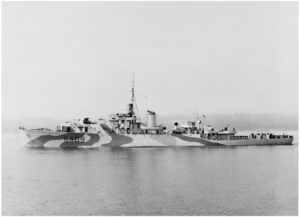OFFICIAL HISTORY OF
The “River” Class Frigate, HMCS CAPILANO, was laid down on 18 November 1943 in the yards of Yarrows Limited, Esquimalt, B.C. She was launched there on 8 April and commissioned on 25 August 1944. She was named in honour of the city of North Vancouver, B.C. The name itself comes from Capilano Creek, a stream flowing into Burrard Inlet near the city.
On 27 September, she left Esquimalt for Halifax, arriving on 20 October. On 9 November she sailed to Bermuda to “work up” with exercises. Back in Halifax, she was allocated to the Mid-Ocean Force for duty with Escort Group C-2. On 4 December, she left for the United Kingdom in company with her group and Convoy HX-223.
Another convoy she joined, this on 19 February 1945, was SC-167. The crossing with it remained a quiet one until the end was almost in sight. The British freighter, SS King Edgar, had engine trouble. On the 23rd, she had to stop for an hour, so that repairs could be made. This meant that she had to be carefully screened while she drifted. The next day, she broke down a second time and had to stop again for an hour.
At 0730Z on the morning of 2 March 1945, this ship was torpedoed. The attack occurred south of Cardigan Bay, Wales, near Strumble Head. Ordered to close the stricken vessel, CAPILANO took off thirty-six survivors, including eight stretcher cases. King Edgar had been struck in the stern and remained afloat for several hours before sinking. Another ship in the convoy, the Norwegian freighter, Novasli, remained afloat in a similar manner after being torpedoed at 0800Z. At 1400Z when the convoy was off Milford Haven, Pembrokeshire, CAPILANO detached to land her survivors at Pembroke.
Almost two months later, at the end of April 1945, CAPILANO picked up five men from two rafts. They were survivors from the MV Panama, a straggler from a convoy, whose cargo had shifted on the 11th, causing her to capsize. The frigate landed them at St. John’s.
On 1 June 1945, with the war over, CAPILANO left C-2 and the Mid-Ocean Force, both of which were disbanded, and proceeded to Shelburne, N.S., to begin a refit. This was completed on 14 October and the ship then returned to Halifax, where, on 24 November, she was paid off into the Reserve Fleet.
In January 1947 several frigates, including CAPILANO, were recommended for disposal. But, in the case of CAPILANO, a strike among miners in Cape Breton brought about a temporary stay of execution. Because it caused a coal shortage on the island, it was decided to have the ship towed to Point Edward Naval Base, near Sydney, so that she could supply steam there for central heating.
CAPILANO remained at Port Edward until 5 September 1947, and then was finally turned over to War Assets Corporation for disposal.


 CFB Esquimalt Naval and Military Museum
CFB Esquimalt Naval and Military Museum
 CFB Esquimalt Naval and Military Museum
CFB Esquimalt Naval and Military Museum CFB Esquimalt Naval and Military Museum
CFB Esquimalt Naval and Military Museum CFB Esquimalt Naval and Military Museum
CFB Esquimalt Naval and Military Museum CFB Esquimalt Naval and Military Museum
CFB Esquimalt Naval and Military Museum CFB Esquimalt Naval and Military Museum
CFB Esquimalt Naval and Military Museum CFB Esquimalt Naval and Military Museum
CFB Esquimalt Naval and Military Museum CFB Esquimalt Naval and Military Museum
CFB Esquimalt Naval and Military Museum CFB Esquimalt Naval and Military Museum
CFB Esquimalt Naval and Military Museum CFB Esquimalt Naval and Military Museum
CFB Esquimalt Naval and Military Museum CFB Esquimalt Naval and Military Museum
CFB Esquimalt Naval and Military Museum CFB Esquimalt Naval and Military Museum
CFB Esquimalt Naval and Military Museum
 CFB Esquimalt Naval and Military Museum
CFB Esquimalt Naval and Military Museum CFB Esquimalt Naval and Military Museum
CFB Esquimalt Naval and Military Museum CFB Esquimalt Naval and Military Museum
CFB Esquimalt Naval and Military Museum CFB Esquimalt Naval and Military Museum
CFB Esquimalt Naval and Military Museum CFB Esquimalt Naval and Military Museum
CFB Esquimalt Naval and Military Museum CFB Esquimalt Naval and Military Museum
CFB Esquimalt Naval and Military Museum CFB Esquimalt Naval and Military Museum
CFB Esquimalt Naval and Military Museum CFB Esquimalt Naval and Military Museum
CFB Esquimalt Naval and Military Museum CFB Esquimalt Naval and Military Museum
CFB Esquimalt Naval and Military Museum CFB Esquimalt Naval and Military Museum
CFB Esquimalt Naval and Military Museum

 CFB Esquimalt Naval and Military Museum
CFB Esquimalt Naval and Military Museum CFB Esquimalt Naval and Military Museum
CFB Esquimalt Naval and Military Museum CFB Esquimalt Naval and Military Museum
CFB Esquimalt Naval and Military Museum CFB Esquimalt Naval and Military Museum
CFB Esquimalt Naval and Military Museum CFB Esquimalt Naval and Military Museum
CFB Esquimalt Naval and Military Museum
 CFB Esquimalt Naval and Military Museum
CFB Esquimalt Naval and Military Museum



 CFB Esquimalt Naval and Military Museum
CFB Esquimalt Naval and Military Museum



































 CFB Esquimalt Naval and Military Museum
CFB Esquimalt Naval and Military Museum CFB Esquimalt Naval and Military Museum
CFB Esquimalt Naval and Military Museum
 CFB Esquimalt Naval and Military Museum
CFB Esquimalt Naval and Military Museum